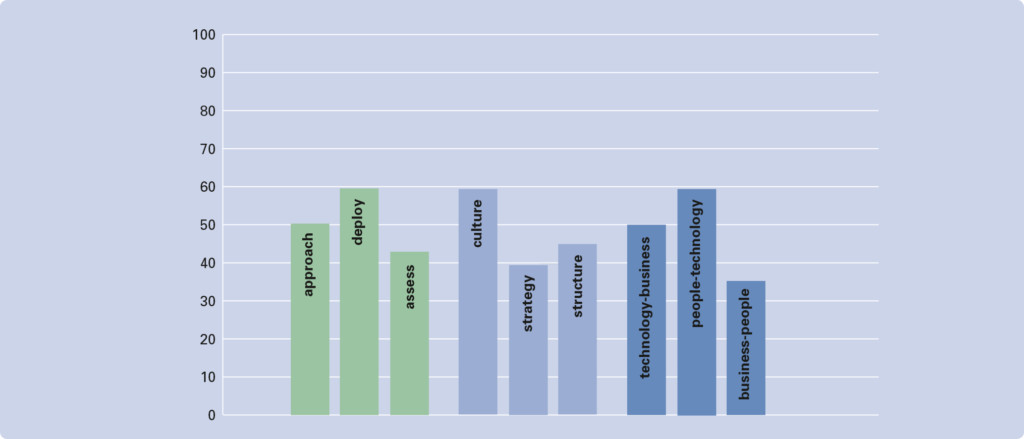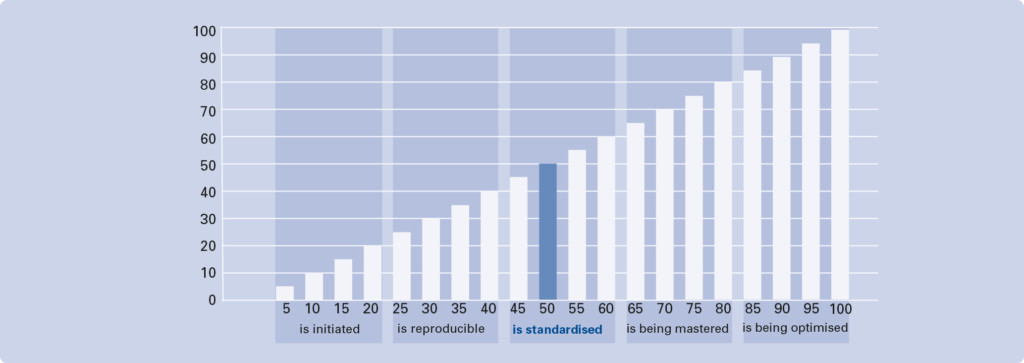Fit for 4.0?
Toolbox | digital maturity
Are you unsure about the impact of digitalisation on your company?
We analyse the digital maturity of your organisation. With our approach to maturity assessment and with our many years of experience in transformation processes, we offer you the complete solution on your way.

Do you want to make your organisation fit for the next step in digital transformation?
Nothing works without digitalisation – automated and networked processes will continue to increase, the “Internet of Things” is finding its way into more and more branches and professions.
The digital maturity of a company consists of thinking about people, technology and business in their interactions in all measures. To know “Where are we in these interactions?”: Use our ‘Digital Maturity’ analysis tool.
An example presentation of an analysis of the digital maturity level

Digital transformation in your company
With our analysis tool ‘Digital Maturity’, you receive a tool-supported orientation. You can do this alone with the help of a questionnaire – or together with others, for example in a workshop. After answering 54 questions, you will receive a result on the maturity level of your company in the digital transformation. Interactions between people, technology and business are illuminated. The result shows which topics require the most action. Depending on your corporate strategy, the existing organisational and operational structure as well as the formative organisational structure, you now decide which of these building sites should be tackled when and by whom. We will be happy to advise you on your path to digital maturity.

Digital transformation is more than digitisation
In most organisations, digitisation is seen as a matter for the IT department and the data protection officer also takes care of it. But this is too short-sighted. Technology may be the trigger for digital transformation, but the greatest impact occurs on two other levels: How are processes and structures changed and what are the consequences for the number and quality of jobs? And: How do the requirements for employees change in terms of technology, communication, documentation or scope for decision-making and responsibility?
This addresses the three corners of the digital transformation:
- the digital technology
- the impact on the organisation
- the impact on peopleIm besten
Things get literally exciting when the interactions between these three corners of the digital transformation come into play.
At the interface of technology and organisation, it is about the integration of new technologies into existing work and production processes or overall operational systems.
In detail, the following questions and tasks arise regarding analysis, planning, implementation and evaluation:
- How are suitable processes of digitalisation identified? In other words, what other processes can be supported with existing technology?
- What consequences does digital technology have on the forms of work organisation? In addition to the autonomy of teams and individuals, this also includes new ways of reporting and approval processes as well as scope for other “agile” forms of organisation.
- What are the consequences of all this for power shifts and the organisational hierarchy – how exclusive will information, communication and decision-making powers be for whom?
At the interface of man and technology, the issue is the attribution of control between machine and man as well as the degree of automation and thus also the significance of manual production work.
In detail, the following questions and tasks arise regarding analysis, planning, implementation and evaluation:
- How are digital technologies selected and used so that they optimally support employees in their work?
- What physical, mental and professional challenges arise from the new human-machine collaborations?
- How great is the acceptance of these forms of human-machine work among the immediate users as well as in the wider work environment?
At the interface of organisation and people, it is about the design of work organisation, activity structures, qualification requirements, management and communication structures.
In detail, the following questions and tasks arise regarding analysis, planning, implementation and evaluation:
- What targeted measures will prepare employees for future digital challenges? This includes the challenges of communication, control and consultation much more than the purely technical-instrumental ability to operate technology.
- How are employees prepared for the fact that changes in work content and requirements are becoming less and less predictable and plannable?
How are human resource planning and development aligned with existing and planned digital tools and changing work environments?
Three levels of digital maturity
The result of the analysis tool always refers to three intertwined levels:
- Interrelationships between Technology – People – Business
- References to the ordering moments of culture, strategy and structure
- Project phases of planning, implementation and evaluation
In this way, you not only receive detailed analyses, but also precise indications as to which of the combinations of interdependency, moment of order and project phase present the greatest challenges of the digital transformation. For the management, it makes a difference whether you work next on planning a strategy at the interface of technology and business. Or on the implementation of cultural changes in people – technology. In order to avoid flying blind, doing what seems obvious (but is wrong) or going astray, you should manage the digital transformation in a targeted way. Don’t just follow it … just as a baker doesn’t just crumble ground grain into rolls, but juggles customer expectations, new creations, oven technology and employee qualifications on a daily basis.
You can now request the “Digital Maturity” analysis tool as part of our consulting services. We will then discuss the digital state of affairs and the next steps together and get them up and running. Get in touch with us.
You can find more information about our consulting services in digital transformation here.


